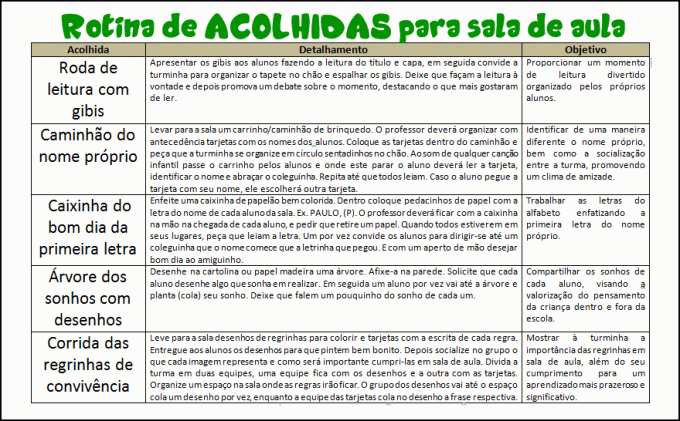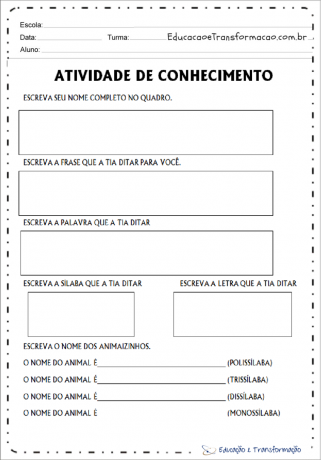
We selected in this post some suggestions for the first day of school, a Back to School Routine for Early Childhood Education.
Index
Check out the back-to-school routine for Kindergarten indicated for the first week of classes, created by the wonderful teacher Valéria from the blog Teaching with Care:

The water falls in the spout
lathers with soap
To eat lunch
I already washed my hand
Lyrics: Carminha Soares
Music: ciranda cirandinha
It is clear that each teacher must adapt this activity plan to their reality and the reality of their students, to their school schedules, excluding or including in it what is necessary. It is also important to remember that the routine does not always follow as planned, unforeseen events happen: some children may need more attention, they may cry on the first day and find it difficult to leave their parents at the entrance, among other things that may come to happen, such as the delivery of materials, which can always “muse up” this routine a little and can be scheduled for a meeting with the responsible. The teacher, in this first week, should not be alone, but he/she needs to count on the help of coordinators, assistants, etc.
On the following days, visits to the different departments of the School should be guided, especially for the new students, so that they get to know the new environment in which they are inserted and have no major difficulties in adaptation.
They can also be inserted on the other days of the first week: games, finger painting, toys, musical gymnastics (to make gestures with them while the music plays), drawing to music (drawing with music), Free painting with ink, tearing up magazines or newspapers, modeling, collages, kneading paper, playing on a train to the sound of music, walking on string, crawling on mats, rolling, stamping little hands with ink etc. Your master sent Patati Patatá is a good suggestion to play with!
See also:

Back to School Routine for Early Childhood Education

Represent a tree on brown paper or cardboard; affix it to the panel or wall. At the top of the tree, write a question related to the subject (it could be about environmental issues, rules of coexistence, the school environment etc) that will be dealt with during the bimester, trimester… E.g. were…?
Each child will receive a “tree sheet” to write their dream, the dream is what the child hopes to “happen best” for the subject in question. Then ask each child to place their leaf on the dream tree.
Note: This activity can be resumed during the period in which the subject is being worked on, or at the end of the period so that there is a reflection on what they wanted and what they were able to achieve.
These activities are ideal for the child to realize the need for the organization to perform the activities well. The teacher can, from the children's speech, raise some rules for the organization in the classroom.
Ask the children, all at the same time, to sing a song to their partner next door (this activity will create chaos); then ask a student to sing her song for the class. Children will realize how unpleasant chaos is and how order has meaning.
The teacher will be able to raise with the children other situations experienced where organization is essential.
(Awaken in the student the pleasure of working together and the importance of individual action in contributing to the whole. The teacher will be able to talk a little about the work in the series, so that the children understand the importance of everyone's involvement in carrying out the work).
In a certain place in the East, a king decided to create a different lake for the people of his village. He wanted to create a lake of milk, so he asked each of the residents of the place to bring only 1 cup of milk; with everyone's cooperation, the lake would be filled. The very excited king waited until the next morning to see his milk lake. But such was his surprise the other day, when he saw the lake full of water and not milk. Then, the king consulted his adviser who informed him that the people of the village had the same thought: “In the midst of so many glasses of milk if only mine is water, no one will notice…”
Ask the children: What value did the king's idea lack to complete itself? After the discussion, it is interesting for the students to build something together, such as the classroom panel. The room can be decorated with a cutout that, after being perforated, forms several people holding hands, like a chain.
Check out other suggestions at:
The organization of time is one of the biggest challenges in providing children with quality care and education. Every moment of life in preschool should be a time full of stimuli, challenges and opportunities to learn. For this to happen, it is essential to plan the activities of each day well, in the context of a weekly or monthly work plan.
Below are 9 essential steps of routine back to school for early childhood education:
This is the most important part of a child's day at preschool. Once the difficulty in separating from the parents is overcome, the child learns that he is welcome. Who receives it, how it is received by adults, teachers and peers sets the tone of the day and their perception of preschool life. Arrival is also the time to form important habits: locating and storing objects, putting on and taking off clothes, tying and untying shoes. The child must acquire autonomy in these matters within the first few weeks. The presence of an adult is essential to guide the formation of habits and sequences, as well as to encourage the child to progressively become autonomous.
There are two most common ways to start the day: in some schools, the child goes to the classroom and has freedom to do what you want or you can play on the patio, even organize some activity; in others, the children go directly to an activity organized by the teacher. This activity can be the usual wheel, or something the teacher has prepared to engage the children directly in it. The most common is the wheel, and there are several forms and schedules for it, among which we highlight:
Snack time is a privileged time for the formation of hygiene and health habits, organization, social behavior and psychomotor skills. But it is, above all, a privileged time for an adult-child interaction very similar to life at home. The possibility for the teacher to sit with the children and talk in a free and relaxed way should be seen as a unique moment.
In a dynamic school where the child has varying degrees of freedom to come and go and choose tasks and friends, recess is not much different from other moments in preschool. The existence of adequate spaces and equipment and the presence of other adults can also help a lot in the development of social behaviors. Ensuring children's safety should be a primary concern, and like everything else in safety, prevention is always the best medicine.
Children vary greatly in their need for rest and the length of rest. Needs tend to reduce over time, but like any habit, rest must be anticipated and nurtured. The school may decide whether children who are not in the habit of sleeping should remain quiet while resting or if they can participate in other activities. Furthermore, there are times when the child needs time and isolated space to recover.
There are several important questions regarding these themes.
The farewell must be preceded by a review of the day. This helps children develop a sense of planning, predictability and stability. It also helps in developing memory and organizing narrative structures. Before the end of the day, there are precautions to be taken into account:
Depending on available resources, children can have time to do whatever they want in different spaces in the room. If this is possible, the teacher must ensure that the children circulate in the various spaces on different days, to prevent them from always doing the same thing. This is usually done by forming pairs or cracks and encouraging children to play together. These are important moments for children to develop their individuality, learn to play in groups of two, three or more; and they are precious moments for the teacher to observe the children and engage in real conversations around the activity the children are doing. Real conversation means long dialogues, in which the teacher encourages the child to elaborate their thoughts, feelings, explain the action, etc. It's the opposite of doing quizzes with questions and answers or giving orders.
Each day the teacher will organize two, three or four activities, using the available materials. The activities must be planned in a spaced way, but they can be sequential: for example, the teacher you can read a children's story and then do an activity or a drawing on the text. read. Careful preparation for each activity should be done as this eases the transition and helps children focus on what they are about to start doing.
Subscribe to our email list and receive interesting information and updates in your email inbox
Thanks for signing up.


